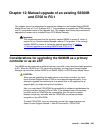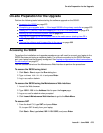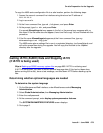
Manual upgrade of an existing S8300B and G700 to R3.1
672 Installing and Upgrading the Avaya G700 Media Gateway and Avaya S8300 Media Server
To check the IA770 stored messages size
1. On the Maintenance Web Interface, under Miscellaneous select Messaging
Administration.
2. Select System Configuration and Status > System Status.
Look for “Used Hours of Speech” in the list. If more than 72 hours is reported, the customer
must delete some messages before the upgrade.
Or, you can use the CLI command, /vs/bin/util/vs_status.
Obtaining an IA770 service pack file
If an IA770 service pack is required after the upgrade, obtain the service pack file from the
Avaya Support web site.
To obtain an IA770 service pack file
1. On the Avaya Support website, double click on Messaging in the list on the left.
2. Scroll down to the INTUITY links and double click on IA 770 INTUITY AUDIX Messaging
Application.
3. Double click on All Documents.
4. Under Software Download, double click on the service pack for this release. For example,
IA 770 INTUITY AUDIX Embedded Messaging Application Patches for 1.3.
5. Double click on the service pack file name. For example, C6039rf+c.rpm
6. Click on Save and browse to the location on your laptop where you want to save the file.
Obtaining optional language files
Optional languages are any language other than English (us-eng or us-tdd). If optional
languages other than English are used for announcements, you will need to download the
optional languages from a language CD after the upgrade. Before going to the site, obtain the
appropriate language CDs or determine that they are available at the site.
Completing the RFA process (obtaining license and password file)
Every S8300 media server and local survivable processor (LSP) requires a current and correct
version of a license file in order to provide the expected call-processing service.
The license file specifies the features and services that are available on the S8300 media
server, such as the number of ports purchased. The license file contains a software version
number, hardware serial number, expiration date, and feature mask. The license file is
reinstalled to add or remove call-processing features. New license files may be required when
upgrade software is installed.


















